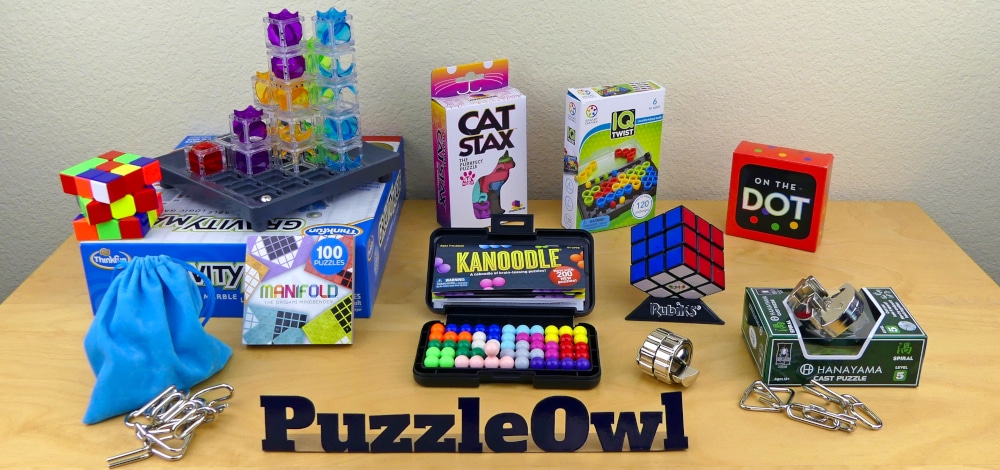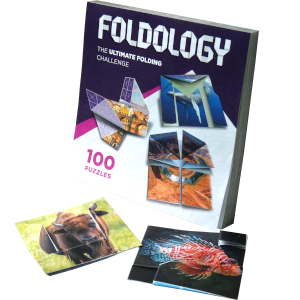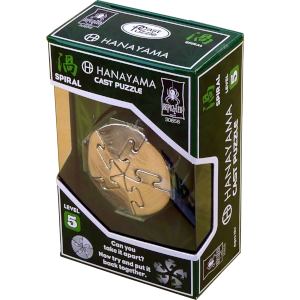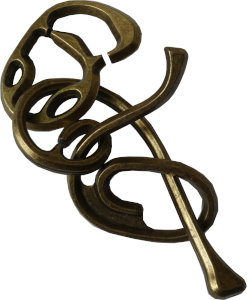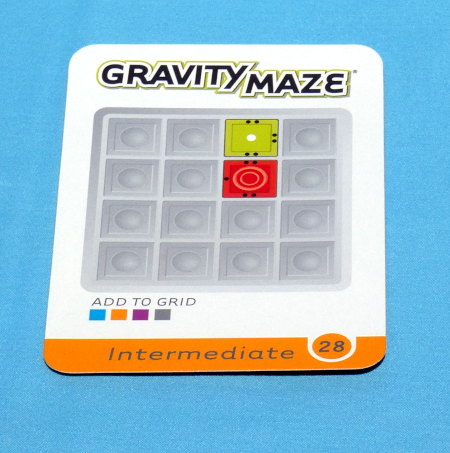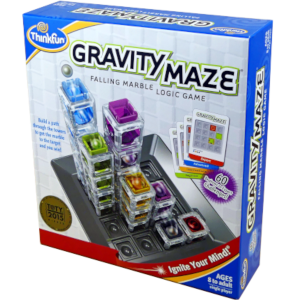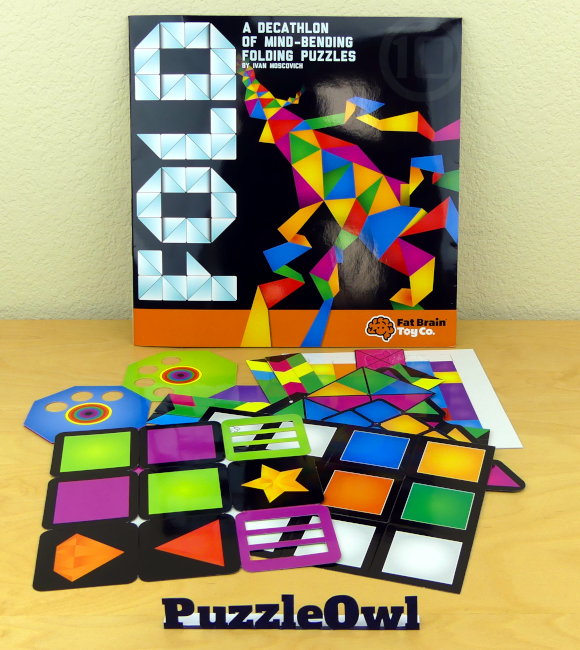Best Brain Teaser Puzzles of 2020
PuzzleOwl's In-depth guide to the top three puzzles picked for 2020, along with some others considered.
Updated November 2020
About This Guide
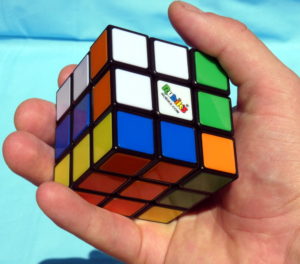
Puzzles have been a passion of mine from youth, starting from when I was first introduced to the Rubik's cube. That is a legendary puzzle that's permeated our society, but puzzles have evolved tremendously since then. Today, there are countless puzzles out there, and new ones are coming out each day it seems, it's getting hard to keep up! It's a great time to be a puzzler.
At the top of this page are just a few of my favorite puzzles, brain teasers, and logic games that are in my collection and took part in this review. Some of these puzzles I've had for quite a while and it was really nice to have a reason to dust them off for a bit of research. Many other puzzles I've bought just this year, to make sure this review is truly current for 2020. I selected just upwards of 60 puzzles to analyze as candidates for this review, and left out many others that I knew straight away wouldn't be strong contenders.
Putting this guide together and going through all the puzzles has been a real pleasure for me. It's one thing to just play with a puzzle, and quite another to do so while consciously looking to pick out the best ones. At the end though, I found that there were three puzzles that really led the pack by a large margin, and quite naturally these became the top three winners, for which I'll unpack my reasoning below.
Besides just the winners, you'll find the puzzles that I thought were also great, but fell short by one reason or another. I would still recommend these puzzles, especially to certain types of people, just make sure to read the accompanying notes so you know what you're getting yourself into.
PuzzleOwl is my passion project, and as a guy who loves puzzles it gives me joy to write these reviews and help people find amazing puzzles that they'll love. Please support PuzzleOwl by using the links on this page if you're interested in a product, because I may earn a commission from Amazon if you buy something. It has absolutely no impact on the price you pay, and it allows me to keep this site up and running.
Jump To
In-Depth Review of Foldology
In-Depth Review of Hanayama
In-Depth Review of Gravity Maze
More Great Puzzles
Also Considered
Selection Process
Let me start by acknowledging that there are many good puzzles out there of many different types — too many to count. That fact alone guarantees that different people are going to have different favorites. For example, I know a lot of people who love twisty puzzles above all else, while others are really into disentanglement puzzles instead.
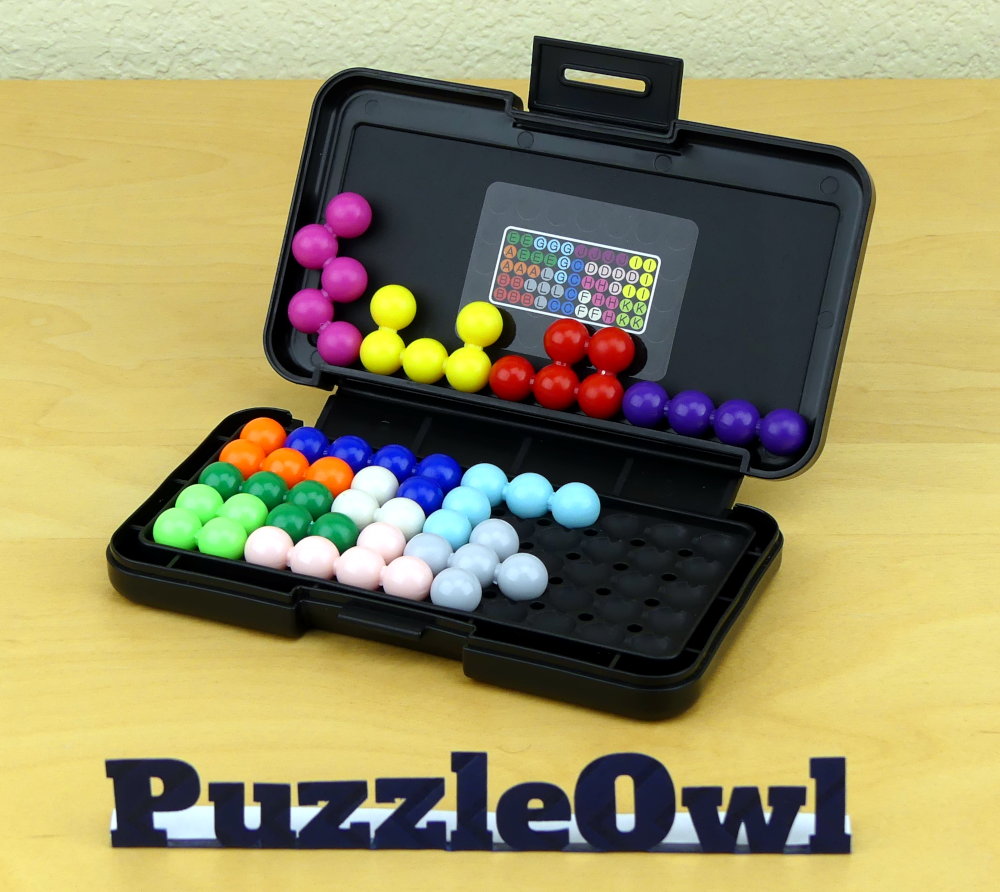
Taking this into account, this guide was put together with an express intention of broad appeal, and avoiding the puzzles that are overly niche. I chose puzzles with simple, elegant concepts that would challenge and delight novice and veteran puzzlers alike. Just below, I'll summarize briefly what I look for in puzzles and how I evaluate them, but you can read about in more detail here. I encourage you to give this page a gander if you want to understand how the puzzles here earned their spot. Although, I also do explain each individual review in detail, so feel free to just keep reading.
First, this guide is about puzzles, not just games, and also not just abstract stuff like riddles. More specifically, for the purposes of this guide, a puzzle has these characteristics:
- It presents a challenge to be solved. Not just a game.
- It's single-player
- It's a real, physical object
- it's challenging but also fun.
To briefly sum up what makes a great puzzle stand out, it comes down to the following:
- an elegant, intuitive concept that's exciting right away
- balance between challenge and satisfaction
- the more challenging the better, provided that it's still fun
- balance between experimenting and strategy
- good design that complements and enhances the core puzzle concept
- good quality of manufacturing and materials
- the only frustrations in the puzzle should arise from the concept, not how the puzzle was made
- value in terms of quality puzzling time for the price you might pay
Besides this, each puzzle was also scored on various metrics. It's important to note that these scores do not determine the rankings in this guide (though the best ones do tend to have better scores). The scores can be used to quickly compare puzzles on a particular aspect that's interesting to a reader, but they're not used as rigid criteria because they hardly tell the whole story. You can read about the scores on that same page where I describe how to find the best puzzles, but I'll briefly introduce them here too:
- Age Range: Which ages, broadly speaking, could enjoy this puzzle? I typically give two ranges, a wider one that means "could enjoy" and a narrower one that's "best for".
- Quality & Design: do the materials, manufacturing, and design elements add or detract from the experience?
- Wow! Factor: How much surprise and excitement is there that makes you think, "Wow! that's amazing".
- Entertainment Value: The quality of play and the amount of it, relative to the price.
- Mental Workout: The depth and breadth of mental skills employed in finding the solution
- Sensory Engagement: The depth and breadth of physical interaction with the puzzle
- Drawbacks: Not really a score, but I'll note down the drawbacks and their impact.
1. Foldology - Origami Puzzle Game
At A Glance
Age Range: 10+ (12+ Best)
Quality & Design: 
Wow! Factor: 
Entertainment Value: 
Mental Workout: 
Sensory engagement: 
See Detailed Score Breakdown
What Stands Out
- Solid product quality
- Awesome difficulty progression
- Amazing value from the 100 puzzles
- Great balance between challenge and fun
What's Lacking
- Purely functional packaging
- Each individual puzzle is single-use
- No solution key
Main Takeaways
Foldology is a gripping new puzzle game based on a simple yet awesome concept that draws from origami paper folding techniques. The goal is for you to figure out how to put a picture back together, and to do that you'll actually fold the paper. As you work through the puzzles, you'll pick up new folding techniques and tricks that will become instrumental in later puzzles.
I was really blown away by the depth of this puzzle. It's a really unique concept, and it makes your brain work in a way that it's not used to doing. Because of that, it fully engages your spatial abilities, and it's tactile, which leads to a really good immersion in the puzzles. I particularly liked the difficulty progression, it's a bit steeper than most other puzzle games, and this contributes to a higher age range, best suited for 12+ and adults. But this is what makes the puzzle so good, because it's very satisfying to fold and yet you're encountering a consistent challenge.
The quality of the materials and manufacturing contributes majorly to the overall experience. I really get into this later, but it's printed on paper that seems to be extra durable and thin at the same time, which really facilitates folding.
What really makes this puzzle stand out is how much entertainment value you're actually getting. I think you could take 10 random individual puzzles from this set and have yourself a game, but Foldology has 100 total. Now combine that with the steep difficulty progression, and you're getting a real challenge from each one, not like other mass-market games where the first half is basically filler. Unfortunately each puzzle is single-use, but the quality and quantity of the puzzles more than makes up for that.
Deep Dive
Description
Foldology is a set of paper-folding (think origami) puzzles. It's not really much to look at, just a little booklet, albeit with a nicely illustrated cover. The booklet is small, measuring just about 4 by 4 inches, and it's got 102 sheets making it just about 3/8 inches thick. Besides the cover and the instructions sheet, the rest of the sheets in the booklet are the 100 puzzles. It's got a glue binding up top, which makes each puzzle easily removable from the booklet.
Concept
Pretty simple: you start with a square piece of paper, and you fold it into a smaller square. However, the design on the paper is broken up into geometrical shapes. The shapes are either fragments of a picture or just a solid color. The goal is to find a way to fold the paper to get the full picture to come together on one side, and the solid color on the other side. It's very satisfying when the picture comes together at the end. It's a bit cumbersome to explain this in words, just check out the before/after picture below.

Getting into it
Since this was a new puzzle for me, I can recall the full experience. I started off by doing the first 6 puzzles, which were pretty straightforward. Right away, I noticed it was taking a little bit for my brain to adjust to even thinking in this way. You have to imagine how the paper could fold and then how it would look afterwards, and what folds you might be able to do for the next step. I'd do that, only to find that it didn't look anything like what I'd planned for it to look like after the fold. "Huh", that left me feeling a bit silly, but I'd reverse it and then able to understand a bit better how this thing was folding. In any case, the first few puzzles only require a few (3-5) folds to complete, and by the 6th one I felt like I was getting the hang of it.
The puzzles increase in difficulty, so in typical fashion I jumped forward to somewhere in the 30s to see if they'd be a bit more of a challenge. I was pleasantly surprised by getting stuck on the one I had landed on. I gave it about 20 minutes of folding and unfolding in a bunch of different ways but it seemed like I was missing something. So, I decided to go back and try an easier one rather than risk ripping the paper and ruining one of the puzzles.
I decided to just go back to where I'd left off originally, and I'm glad I did. First of all, each puzzle seemed like it had something new or more complex than the preceding ones. Second, the difficulty started ramping up pretty quickly, and several new types of folds were introduced even in the first 20. Learning these folding techniques early on let me apply them in the later ones, or I would have been undoubtedly stuck. So I'd encourage everyone to stick with the progression and avoid the impulse to leap ahead.
Finishing it
After I got started, I was embroiled with the puzzles for several weeks and did every single one in the deck. There were several puzzles that I got stuck on, sometimes for days at a time. I would set them aside and go on to the next puzzle, but then come back to them later with a fresh attempt.
Some of the puzzles get remarkably elegant, especially towards the end. They either have a deceptively simple design, or a highly-symmetrical one, and require some elaborate folding technique that you'd wonder how you ever came up with it. Because you had to build up to it, this gives an awesome feeling like you're unlocking or discovering something cool that you wouldn't have been able to experience otherwise.
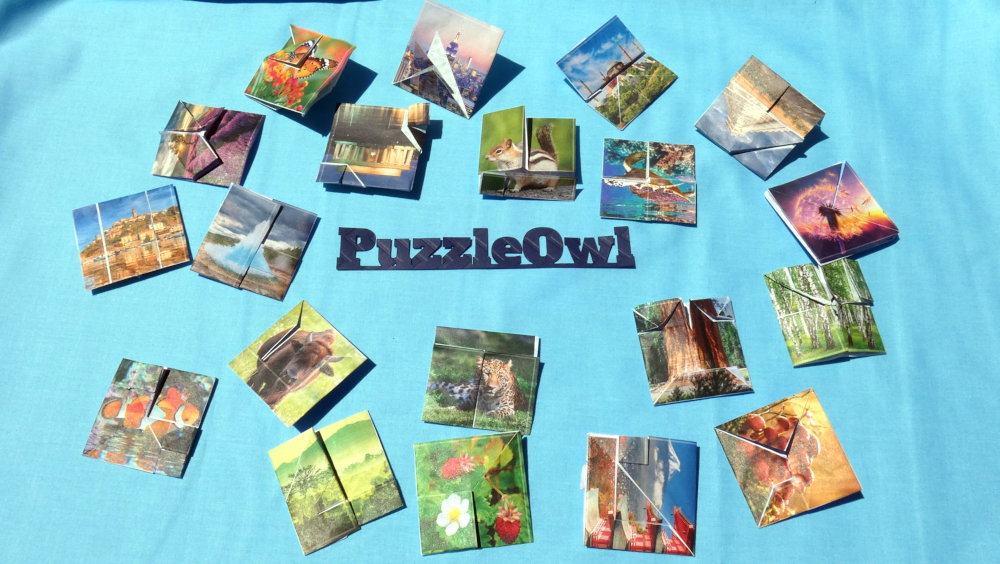
Quality & Design
There's really a lot to dig into on the quality of this puzzle, so I'll elaborate here. As I noted from the very start, it doesn't look like much from the outside - no fancy packaging. Despite that, I rate it very highly on this metric, and here's why:
I've come across several folding puzzles, and for some reason all of them use some type of thick and glossy paper. Foldology on the other hand uses a thinner paper, without a glossy finish. This makes a big difference for folding. With the thicker paper, you get something which doesn't fold that well at all. You know this yourself if you've ever tried to fold up a thick towel or comforter; after you fold it over a few times it starts getting really thick, and it doesn't line up anymore. This effect is dramatically amplified when you're dealing with smaller sizes. However, Foldology use a really thin paper. I measured each sheet to be around .0031 inches with my calipers, that's significantly thinner than the regular 20# bond that you might find in your printer.
On the other hand, the paper also seemed extremely durable. I did a side by side comparison of this paper with regular bond, magazine stock, and card stock and it doesn't tear as quickly when repeatedly folding the same crease. For the Foldology player this means that even with many attempts with folding and unfolding the paper, it's not likely to rip and ruin the puzzle (obviously there are limits to how much abuse the paper can take, but you're not likely to get there on most puzzles).
Last (but kind of least), the Foldology paper is without a glossy finish, which gives another advantage. When you fold a glossy paper, no matter how thin the paper is, that outer glossy layer gets stretched at any crease and can tear. The result is that the glossy layer, where all the color is, can fray at that crease and you'll see the white fibers underneath. This is pretty unattractive if you're folding and unfolding something because it will look ragged when you've actually finished folding it. But this is purely an aesthetic consideration.
Besides the paper quality, the design on each puzzle is beautiful. The colors are vibrant and I loved the pictures. This really added to the experience because it made it all the more satisfying to finish the puzzle (if you fold with care) and get rewarded by a nice picture.
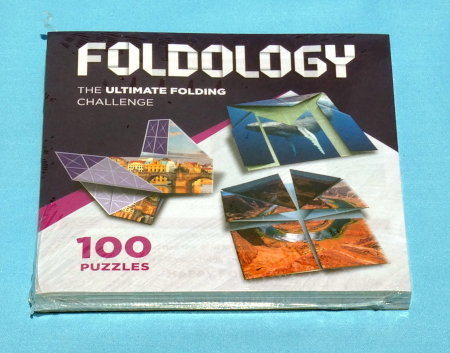
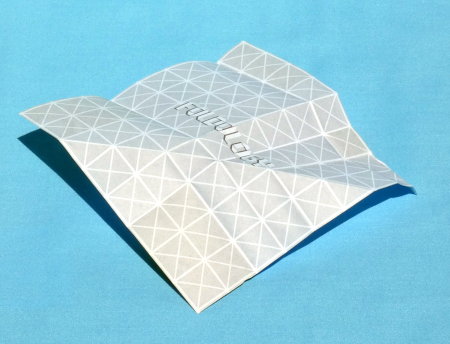
Score Breakdown
Age Range: 10+ (11+ best)
This puzzle is best suited for 12+, but possibly even for kids as young as 10 (if they have good patience or are already into puzzles). The main concern is that you need to be able to fold the paper carefully without ripping it, which requires a bit of dexterity and patience. The puzzles start easy and get quite challenging, so younger kids might not get through all of them However, I think it's still worth it even if they don't get to the end. At the end of the day, if they only make it through 60 puzzles (or 40 or 20), that's still incredible value because they've been challenged up to that point, and they can work through the other ones together with a parent. Otherwise for teenagers and adults, this is an awesome challenge without a doubt.
Quality & Design: 
You can find my whole detailed write-up on this in the deep dive above, but suffice to say that the quality is top-notch and really important for this puzzle. The one caveat is that it could benefit from fancier packaging.
Wow factor: 
There's something about the puzzles being so simple in scope, because at the end of the day it's just a small piece of paper with a finite number of ways it can be creased. That leads to a real appreciation of all the varying ways that the paper can be folded given these constraints. Some of the puzzles, especially towards the end, are highly symmetrical and fold in a really complex and unexpected way. When you figure one of those out it can leave you feeling stunned that it could actually come together like it did.
Entertainment Value: 
Each individual puzzle is great in and of itself, and there's 100 of them. They ramp up really quickly and you're getting challenged with almost each one. There's never really a point where you hit a plateau and just start cranking them out. This means is that the puzzles are not that quick to solve, I'd say on average maybe 20 mins. But, they keep you hooked, which translates to a hefty amount of fun and challenging playing time. That adds up to over 30 hours if that 20 minute estimate is accurate, but it might be even more because there were some that I was stuck on for hours at a time.
This is definitely not something you can blow through in a day or even a few days. The amount of playing time you get, combined with the quality of each puzzle, is really what puts Foldology in the top spot for this guide.
Mental Workout: 
Unless you're already into folding or origami, this puzzle will likely wrinkle your brain, it's a very unique way of thinking. It requires quite a bit of both mental strategy and experimentation. You start off by doing a few folds to see where it could go, but then you might double-back, evaluate your options, and try to think ahead. Then you choose your next fold and start seeing where it leads you again. This is a continuous process of trying things out, punctuated by pauses to consider and ponder — really nice balance of strategy and experimentation.
Another interesting dimension to this puzzle involves the pictures. When you first see the puzzle sheet, the picture is broken up and the pieces are rotated around. If you can figure out what this picture actually is and how it comes together, you can use that to strategize your folding better. Despite these points, it's not as thought-intensive as some other puzzles.
Sensory engagement: 
First, it's something that you're manipulating with your hands; so you're folding, turning, tucking, pinching one corner while simultaneously creasing another. At the same time, you're incredibly zoned-in visually because you have to continuously pay attention to how the paper looks after every fold that you make. It's a precise yet tactile activity, which is a fairly unique combination. It's fully immersive on this level, and pretty much the definition of using your spatial abilities.
Drawbacks: Minor
Each puzzle is single use, because once you've folded it the creases are obvious. The packaging is nothing fancy, the booklet is just wrapped in clear plastic, I don't think this really detracts that much but it doesn't have a colorful box like many other puzzles do.
For the puzzles themselves, you have to fold them pretty carefully if you want the pictures to look good. Also, there's no solution key. There were a few puzzles where i was really stuck that I wished there was a solution to peak at. Of course, I did end up coming back and solving the puzzle so it worked out, but I could see this being a bigger deal for some people.
Final Thoughts
Just an all-around awesome puzzle that brings great value. It's definitely a serious challenge, but that's balanced out nicely by the satisfaction you get solving it, and working your way up the stack into the really elegant puzzles at the end. The cool thing is that you can get a single copy of Foldology, but then share the puzzles with your loved ones and friends. It's really a lot of bang for your buck. This would make a great gift for anyone into origami, anyone into puzzles, even someone who just wants a mindfulness-inducing activity for a part of their day.
In any case, Foldology earns the top spot in this guide. That means, if you're looking for a puzzle, this is the one I'd recommend above all others.
2. Hanayama Cast Puzzles
At A Glance
Age Range: 12+ (13+ Best)
Quality & Design: 
Wow! Factor: 
Entertainment Value: 
Mental Workout: 
Sensory engagement: 
What Stands Out
- Superb quality
- Really unique and clever puzzle designs
- Elegant yet complex concept
What's Lacking
- Tend to be pricier
- Difficulty levels don't always feel accurate
- Not the best puzzle for kids
Main Takeaways
The Hanayama Cast puzzles (Huzzles) stand as giants towering over the puzzle world, with a stellar reputation. Simply put, they are truly remarkable and firmly deserve a spot in the top 3 best puzzles of this guide. It was a really tough call between this classic and Foldology for the top spot.
This is actually a series of puzzles, so each one is generally sold separately. I've only had the pleasure of playing through about 15 of them myself and I'll definitely be adding more to my collection. Specifically, I'll go into my favorite 4 out of those 15 in more detail down below.
These are disentanglement puzzles, and it's pretty much the simplest concept imaginable: take it apart into its component pieces. Then you have the additional puzzle of putting it back together again (though I think the first part is generally more fun). Each puzzle is rated by Hanayama for it's difficulty level, on a scale of 1-6. The puzzles I've linked are among the harder ones, representing levels 4, 5, and 6.
What makes these puzzles earn a spot in the Top 3 is their incredible quality, design, and elegance. They are extremely well made, which is what actually critical for most of the designs to work the way they do (I'll explain this in more detail). On top of that, they are very intricate and challenging, often having several moments along the way where you figure something out and move forward in some way. That feels awesome: having a satisfying moment of progress and still having more ahead.
They're really hard to put down when you haven't figured them out yet. You hold it in your hands and it just seems unbelievable that you can't get these few pieces of metal untangled. Figuring it out feels incredibly satisfying, with a deep sense of discovering something really cool.
The main reason this puzzle isn't at the #1 spot is value, because frankly speaking, they're not cheap relative to how much puzzling time you get with each one. If price wasn't an issue, this series would be at the top, hands down.
Deep Dive
Description
In the US these puzzles are sold by BePuzzled, Hanayama's exclusive distributor. Each puzzle comes in its own little green box with clear plastic that lets you see the puzzle inside. The packaging is nice and gives it the feel of a quality product right off the bat, though undoubtedly I throw the boxes away pretty quickly. Inside the box is an insert that describes the puzzle, usually explaining the name, and giving it a theme to keep in mind while solving. It's a nice touch.
These Hanayama puzzles have been around for a long time and have an incredible reputation. They're somewhat of a gold standard (actually made out of zinc) for disentanglement puzzles. New designs have come out over time starting from 1983, and I believe there have been around 80 of them, though some designs have been discontinued. I like to reward myself every so often by getting another one of these, and the next one will be my 16th.
Below are the 4 individual puzzles that I selected from this series:
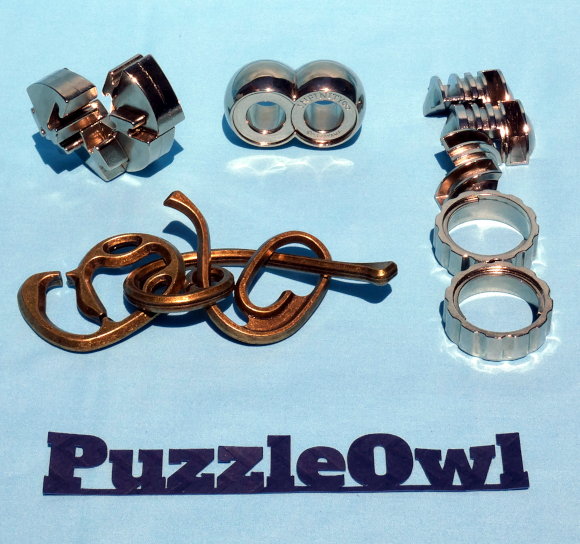 Cylinder (Level 4): Right-most in the photo, disassembled.
Cylinder (Level 4): Right-most in the photo, disassembled.
5 metal pieces packed into a cylinder, with 2 on the outside that can rotate. I'm showing it in its disassembled state to highlight the intricacy inside.
About 2 inches on the longest side. This one definitely seems harder than a level 4, I'd put it as a level 5. It feels a lot like cracking a safe or a lock of some kind. Taking it apart was great, but for me it mostly came down to trying a bunch of different things.
After it finally falls apart though, the real challenge begins to try and put it back together. That requires careful study of all the pieces in order to "piece together" how it actually works. That's less fun than trying to get it open. Overall it's a really solid puzzle, but I think my least favorite of these 4.
Spiral (Level 5): Top left.
This is a really elegant one, 5 pieces of metal intertwined in a solid circle, about 2 inches across. There are no hidden pieces or mechanism, the pieces all move freely so you can see exactly what's going on. It seems hard to believe at first that they could actually come apart, but they do. Very satisfying to complete, and almost as satisfying to get it back together. This one feels a bit easier than it's level 5 rating, I'd put it at level 4. My second favorite out of these 4 just due to its elegance.
Infinity (Level 6): Top Center.
3 metal pieces, 2 cylinders and an outside casing. This one is also 2 inches across. It's pretty tough... I think deserving of the level 6 rating but I could also see it at level 5. It required a bit of logical thinking too, and you can't really just brute force it. Somewhat similar to the cylinder in the way it played out, but I enjoyed putting it back together a lot more.
Enigma (Level 6): Bottom Left.
This one is the king! The hardest one of the 15 that I've done, and my favorite. About 4 inches across when clumped together. It is 3 metal pieces but they don't come together as a cohesive object, instead they are bent and intertwined and moving freely, albeit of course constraining each other. This is another one with the benefit that you can see everything fully from the start. Solving it has several steps, twists, and turns and it's an awesome journey.
Concept
These puzzles have the simplest concept ever, which is one of the main things that makes them so alluring. Here are a few pieces of metal, so just take them apart.
There's just something so appealing to this setup that's hard to put into words, you just need to hold it in front of you to understand. If it's just a few pieces it can't possibly be that hard to figure out, but then when you try: you're stumped! When you finally do figure it out though, there's usually something clever going on that feels really satisfying to figure out.
Getting into it
I typically start out by first reading the insert that comes with the puzzle. I like to get my mind in the right spirit, to better recreate the experience that the designer was aiming for. The next step is to fiddle with the puzzle and see how it moves. As I do that, I start to digest what this puzzle is all about and how I could go about solving it. At first it seems impossible, "how could this thing even come apart, it just seems to move back and forth". But then I try out some ideas, and eventually one of them works and I'm on to the next step. Many of the Hanayama puzzles don't have just one "Ah Ha!" moment, but several.
For the puzzles where the mechanism is hidden inside (like Cylinder, Infinity), there's another cool dimension. Invariably, as you start making some progress, you'll start to see inside the little contraption. You see some parts of the inner workings, like little grooves, that offer more clues to how you can proceed. That in turn leads to more ideas, and more trying stuff out, so it's pretty exciting to make little bouts of progress in this way. Another thing to appreciate is that the puzzles are not necessarily linear; sometimes a move you made seems like it changed something, but it turns out that you're not any closer to solving it. That makes you double-back and reconsider, which definitely adds to the complexity of these puzzles.
Finishing it
They're really hard to put down, because you always feel like you must be so close to cracking it. Finally the thing falls apart. If you're not careful in your moment of triumph to notice exactly how the pieces came together, you'll be left with an even harder puzzle of putting the thing back together again.
At the end though, you can examine the mechanism involved and understand on a deeper level how this thing can come together to do what it does. Whenever I solve one that I hadn't tried before, I'm left awestruck by the creative engineering and cleverness that's at work.
The real sense you get with these puzzles is it's a kind of mystery contraption. Each puzzle is just one, so it's not a ton of bang-for-your-buck in terms of playing time. However, the simplicity, elegance, and quality of these makes for a superb experience that always leaves me excited to get my hands on another one.
Note on the Spiral
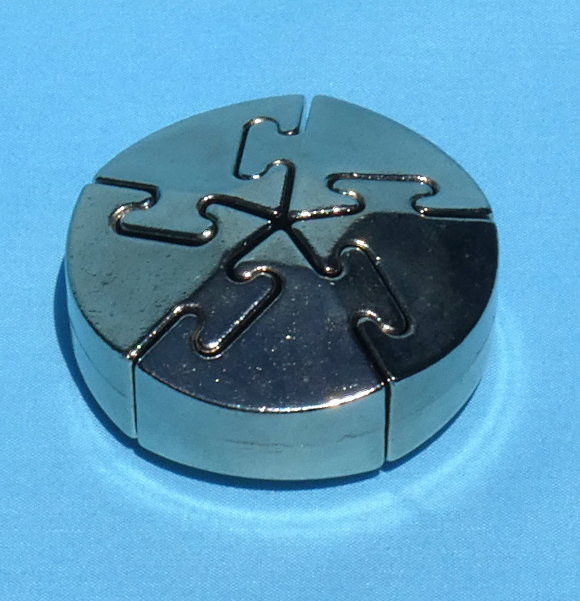 Check out this close-up of the Spiral puzzle. It's less than 2 inches in diameter but it weighs 6 ounces. The 5 pieces fit together sort of like a jigsaw. They look like they're identical, but they're actually all slightly different.
Check out this close-up of the Spiral puzzle. It's less than 2 inches in diameter but it weighs 6 ounces. The 5 pieces fit together sort of like a jigsaw. They look like they're identical, but they're actually all slightly different.
Look how tightly the pieces fit together. This is the degree of quality and precision that enables these awesome puzzle designs to work.
If they were actually jigsaw pieces, they would just come apart. But here, when you try to pull one of them out, it will readily start sliding out until it gets stuck (sometimes just at the edge of being free). There's nothing else involved besides what I've just described, no hidden pieces. How do you take it apart?
If I had to recommend a single puzzle from the Hanayama series, it would be this one.
Score Breakdown
Age Range: 12+ (14+ best)
These puzzles get pretty hard pretty fast. But not only that, the concept itself and the design (all the value that you get from it, really) takes a bit of maturity to fully appreciate. A younger kid might still get a kick out of trying to crack it, but in all likelihood it will go on the shelf right afterwards as just any ordinary toy. For teenagers, it might be more relevant because they're getting into their own hobbies and have their own particular interests, and this could fit into that. These Hanayama puzzles might be especially great for kids with an interest in engineering, math, or related topics. Adults will probably enjoy these a lot.
Quality & Design: 
Stellar engineering designs are at the core of these puzzles. They're extremely well-made out of metal which has real weight in your hands. The pieces are made to very fine tolerances, and most of the puzzle designs actually depend on this feature. That's because the pieces are the precise size and shape that they need to be to move just right. If some pieces were a bit larger or smaller, the puzzle just might not work at all.
The metal is also key, because these puzzles rely on the rigidity of it. If they were just a little bit pliant, the puzzle could be solved by forcing the pieces apart at some junction. That's a lot less satisfying even if you're consciously choosing to not apply any force. It feels better to know that you actually couldn't force if you tried; it makes it a more realistic challenge. It's nice to hold a real metal puzzle in your hand, compared to most puzzles nowadays that are made out of cheap plastic.
Wow factor: 
Wow just wow, these puzzles are cool! They look simple but work in such interesting ways that you'll just be blown away once you figure them out. Really elegant designs, specifically chosen it seems, for delivering clever and surprising "twists". Each one is uniquely amazing.
Entertainment Value: 
Really high quality, really good design and an awesome puzzle, but each one is sold separately and translates to a few hours of puzzling at most. Now, that can be mitigated by the fact that each puzzle is also re-usable, so you can share and get more value that way. They're also just cool things to have on your desk and have value as a collectors item. But in terms of pure "entertainment value", it's not the best bang for your buck compared to a lot of other puzzles. But to be fair, these puzzles are in a class of their own with quality and price to match.
Mental Workout: 
These puzzles will definitely challenge you and make you think. There's both strategy and experimentation. Although, the balance is skewed a bit more towards experimenting.
You're stretching your spatial abilities to figure out how the thing can move. Then you're using logical reasoning to get ideas on what to try and processing what you've figured out about the puzzle. But at the end of the day it's not the most mentally intense puzzle, you can settle into a groove and just play with it for a while without really thinking, instead feeling your way. It's a decent mix of strategy (logical thinking) and experimentation.
Sensory engagement: 
You're visually hyper-focused while twisting and turning the puzzle each way with your hands. There's definitely a need to be very precise with your movements and feel out how the pieces are constrained. On the other hand, this can sometimes get a bit repetitive, and with only a few moving pieces that are interlocked together there's not that much variety in what you're doing at times.
Drawbacks: Minor
Value is the main one. I've already covered this in detail, and it's really not that type of puzzle with 100 challenges to keep you hooked for days at a time.
Another thing is that the difficulty levels seem a bit off. For example, there are definitely some level 5 puzzles that feel easier than some level 4s.
The last minor thing to note is: some of the puzzles also make loud clinking sounds that might annoy anyone who happens to be in the vicinity.
Final Thoughts
This is a puzzle series of the highest quality. It's likely to be a hit with anyone who enjoys tinkering, problem solving, or just appreciates fine and clever design. For someone already into puzzles, getting into these would be a no-brainer.
The only catch is that they are really fine nuggets of goodness. It's like an expensive meal at a French restaurant — it's going to taste amazing, but you might not leave feeling full. Similarly with these puzzles, you'll have an amazing experience for a few hours that's hard to beat but still fleeting. Most likely though, you'll love the puzzle and it'll be totally worth it. The Hanayama Cast Puzzles have been delighting puzzlers continuously over so many years that they must be doing something right.
I recommend the Spiral for anyone starting out with these puzzles, it's really elegant and not too hard. But if you're up to the challenge, go for Enigma, it's amazing and challenging.
3. Gravity Maze
At A Glance
Age Range: 8+ (8 - 16 Best)
Quality & Design: 
Wow! Factor: 
Entertainment Value: 
Mental Workout: 
Sensory engagement: 
What Stands Out
- Combination toy and game
- Hefty size and colorful pieces, like a board game
- Naturally fun concept of constructing a marble run with a goal in mind
What's Lacking
- Some frustrations from the product's quality and design
- Difficulty progression: Not enough harder challenges
Main Takeaways
Gravity Maze is a really well-rounded puzzle game. It's actually both a toy and a puzzle at the same time. More specifically, it takes the basic concept of a marble run and turns it into a puzzle. If you have kids but you've never heard of marble runs check them out because they're great toys. This is definitely the most kid-friendly puzzle in the top 3.
What makes this puzzle great is that it's just a lot of fun to play. It's not as clever as the other ones in the top 3. It doesn't have as many surprises, and it's not as challenging or tricky. The actual game-play of moving the big towers around and constructing something and then watching the marble run the maze is quite pleasing.
It's not as involved on a sensory and mental level. There's a lot of trial and error. There are also some frustrations with the quality and design of the game. Somehow though, all these negatives are outweighed by the fun you'll be having. Gravity Maze is a solid third choice.
Deep Dive
Description
Gravity Maze is nicely packaged, and comes in a sturdy and large box, measuring 10.5 x 9.5 x 3 inches. Inside, everything is neatly packed. The pieces for actual game play are the board, the towers, and the marbles. The board is basically a grid meant for the towers to snap into. The towers are segmented pieces of different length. The segments on each piece correspond to ramps, with different orientations. The puzzle is then how to position the towers on the board so that the marble navigates through the segments of the towers and goes where it needs to go.
Also in the box is a deck of challenge cards. There are 60 cards in total. They are in increasing levels of difficulty. Each card indicates the preliminary setup of the board i.e. which towers are placed where, which remaining towers need to be added, and where is the marble supposed to start and end.
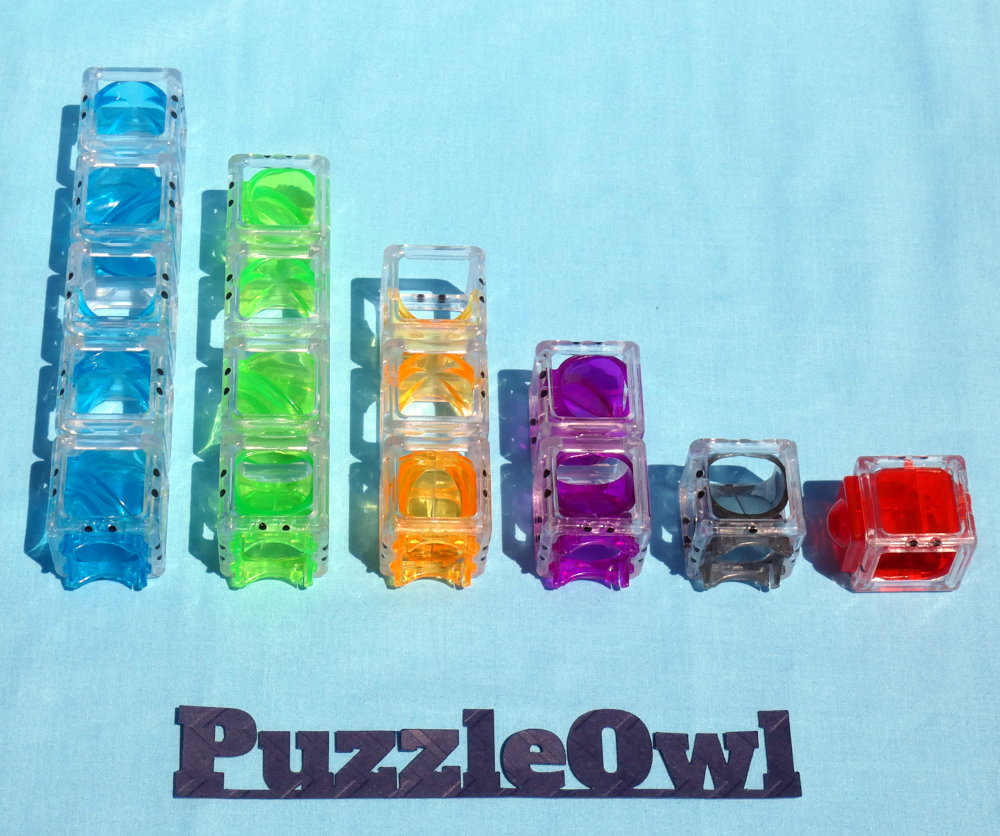
Concept
You're building a maze that guides the marble, from a limited selection of pieces. The awesome part of this is that it's utilizing the fundamental forces of physics, and on an intuitive level it's just very appealing.
On the other hand, there are quite a few detailed rules that you need to read through and remember. These rules limit the possible arrangements of towers that you can construct.
At the end of the day, these restrictions aren't a big deal, but it feels a bit artificial and makes this not as elegant of a concept as some other puzzles. Then again, this really isn't a pure puzzle so that's forgivable.
Getting into it
Every challenge starts with a card. You pick out the pieces you'll need and start figuring out which ones to place on the board and where. This requires interpreting some relatively un-intuitive dot patterns on the card, and matching it to the dots on the towers. This is sort of a mini-puzzle itself, though not a very fun one. But, it's not a big hindrance because the real fun is right ahead.
Once the setup is done, you start trying to place the remaining towers. For me, the early puzzles were pretty easy and the solution was apparent straight away. Some of them actually took less time to solve than they took to set up.
When trying to build out the maze, at each point you have potentially several options for which tower could be used next. Whichever tower is placed then removes that tower from the pool of remaining towers, and that specifies the next spot the marble will go.
You have a small number of towers and you could just try all possible combinations. But, you can try narrowing down the options using logic. This is what the puzzle is basically about.
As the challenges get harder, the possible number of combinations to consider increase, and you have to think harder or just try more configurations. It's not very elegant, but it's challenging and it's fun.
Finishing it
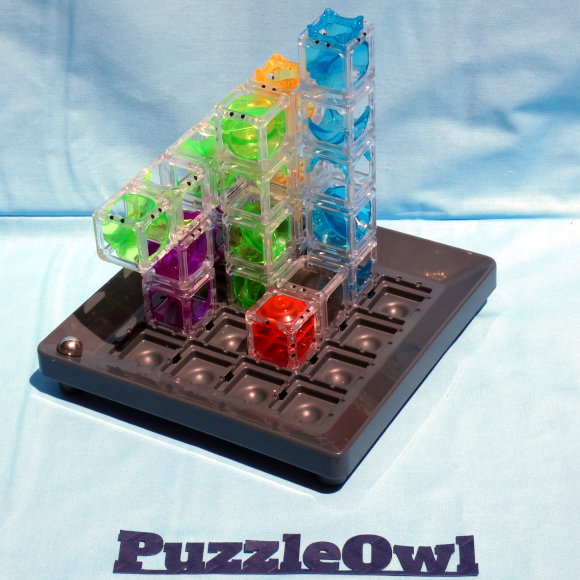 As you get deeper into the stack of challenges, you realize that all the preceding cards have been training you for this moment. You start seeing more challenges with towers that need to be placed horizontally, and some of the solutions involve a cool trick of suspending these horizontal towers above the board.
As you get deeper into the stack of challenges, you realize that all the preceding cards have been training you for this moment. You start seeing more challenges with towers that need to be placed horizontally, and some of the solutions involve a cool trick of suspending these horizontal towers above the board.
This possibility is explicitly spelled out in the rule book (along with nuanced restrictions on how to do it), and finally by the end, you get to see it! This is a really nice twist that amps up the game at the later stages.
However, you only end up using this trick in a handful of challenges, and that feels underwhelming. Actually, I found those challenges to be fairly easy, probably because I had been waiting for the whole game for a chance to use this bridge mechanic. So to me, the end seemed pretty abrupt — like getting to the good part but then it's over right away.
It really feels like there should be more challenges that use this bridge mechanic. Actually, I'd like to see more of the harder challenges in general.
Above, you can see an example of what a solution with that bridge trick could look like: one of the green towers lies horizontally on top of other towers as a bridge
Closer Look
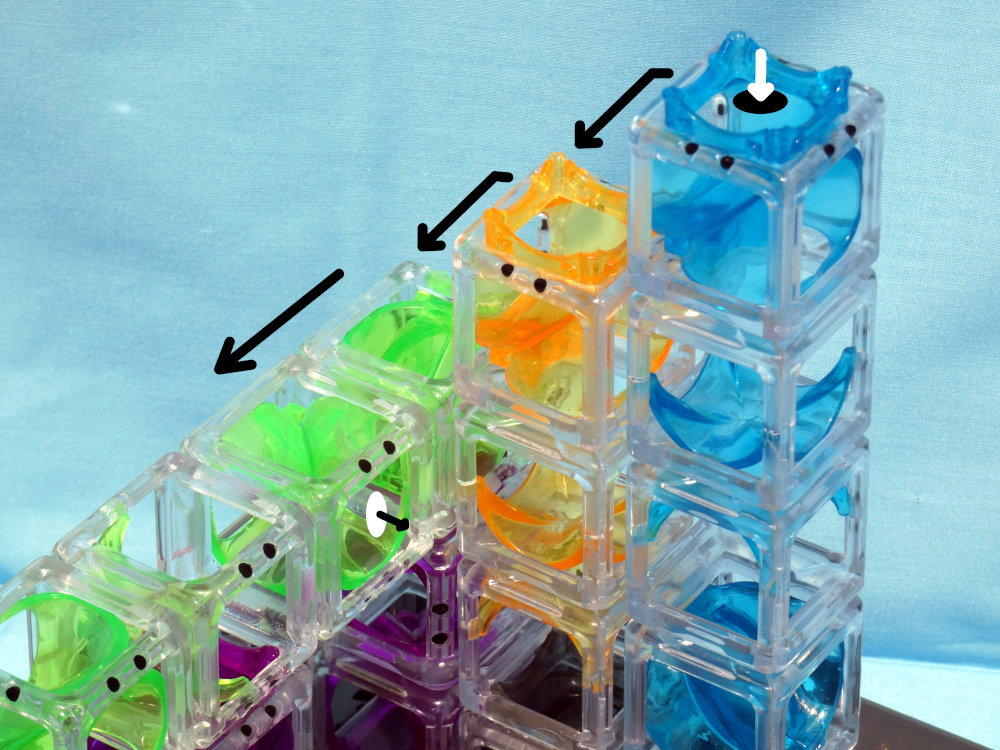
This is a close-up of the setup above. The front-most green tower is removed so you can see behind it.
In this solution, the marble would enter into the blue tower from the top. Then it would roll down through the orange tower, and then into the green, where it gets redirected and passes through two segments of the green tower. It comes out where that other (removed) green tower would be, and then continue its journey all the way to the red tower piece (in the prior image).
Score Breakdown
Age Range: 8+ (10-18 best)
This puzzle is most suitable for kids, but it's also definitely still fun and challenging for adults. For younger kids, the challenge cards may be cumbersome to figure out, and they'll need an adult's help to set up. Although kids could even just play with it like a toy by building their own mazes for the marble, just like a miniature marble run.
Most adults will like this puzzle game and be challenged by it. However, some might find it a bit underwhelming, so there might be better options.
Quality & Design: 
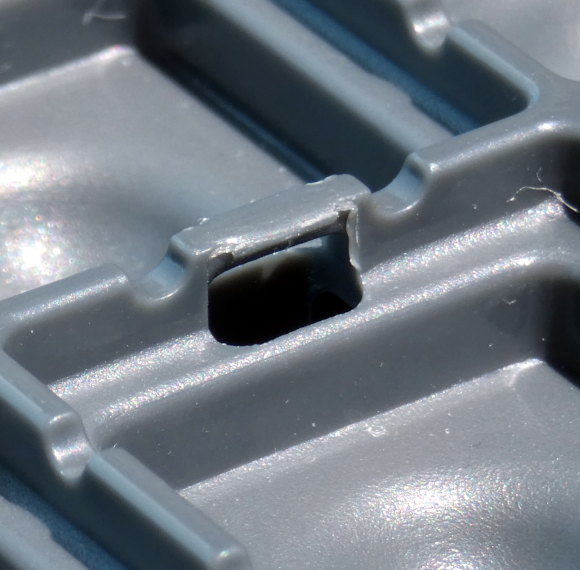 Overall it's nicely packaged, with vibrant colors, and has a nice feel to it. But there are some drawbacks. The main issue is how the towers connect with each other and the board. Both types of connections rely on a snapping mechanism (like LEGOs), to snap into place.
Overall it's nicely packaged, with vibrant colors, and has a nice feel to it. But there are some drawbacks. The main issue is how the towers connect with each other and the board. Both types of connections rely on a snapping mechanism (like LEGOs), to snap into place.
On the right is a close-up of one of the snap connectors on the board. It's supposed to jut out, but you can see it's worn down. The connections start far too rigid and you need to apply a lot of force to snap them in. Repeating this over and over causes these connectors to wear down, and then everything is too loose. It gets flimsy enough that the pieces will readily fall if the board is jostled a little.
Another issue is it's hard to see from a distance the details of each tower, in terms of which way the ramps are oriented within it. That means you might have to lift the towers back up from the board to check this. This is a design flaw, because it could have been marked on the outside of the towers.
Now, granted, I've played this game a lot and a few friends friends have as well, but these flaws seriously detracts from the replay value for the game, and result in frustrations.
To add to all that, when you've solved the puzzle and release the marble to run its course, it sometimes gets stuck randomly in the middle. You then have to tilt the board somehow to get it moving again. Needless to say, this is a buzzkill during your moment of triumph, and it's yet another design flaw because of how the pieces connect with each other that doesn't enable the marble to run a smooth track.
Wow factor: 
It's definitely cool to get the marble to run through the maze. There are also some twists in the later puzzles that involve propping up pieces like a bridge over the board, which adds complexity. However, there aren't that many challenges that end up using this. Most of the puzzles end up being fairly linear. Although they're challenging, they don't end with you feeling like there was something unexpected.
Entertainment Value: 
There are 60 challenges, and the game is really fun to play. You're getting an awesome physical product for a pretty good price. What takes this score down a little is the degrading connector quality over time, which detracts from the replay value of this puzzle.
The bigger issue is that there aren't enough challenges. The really interesting stuff starts happening in the last 15 or so. They could have easily added more of these types of challenges and extended the game without increasing the price by more than a tiny bit; this is just missing value. Regardless, playing it is still just a lot of fun.
Mental Workout: 
This is a highly spatial puzzle, but it's also heavy on logic. You have limited towers to work with to put together an arrangement to accomplish a task, so your mind starts looking for ways to figure that out. I found myself trying to determine some tricks and constraints to find ways to further limit the possible solutions I'd have to try. For example: counting pieces and comparing with the number of tiles the marble needs to traverse.
This puzzle lends itself to more logical thinking than the others in the top 3. However, the score is lowered significantly because the puzzle ends up being heavily skewed towards experimentation rather than strategic thinking. Basically, you can try to come up with logical constraints, but at the end of the day you'll end up trying a bunch of combinations until one of them works.
Sensory engagement: 
This is a lower score than I expected when I first got the box. You're manipulating the pieces and studying them visually, but frankly it's not that in-depth and it's with frustrations. I found that I'd have to repeatedly remove towers from the board to remind myself of which ramps are in which positions. This breaks the flows of just immersing yourself in the puzzle and getting into a nice mind-meld.
On the tactile side of it, you're moving the pieces around but it's not anything skillful, it's purely functional.
Drawbacks: Medium
There are a few issues with the quality and design, and taken together they amount to some significant frustration at times. Additionally, the ramp-up of difficulty in the challenges isn't the best, and there should be more than 60 cards in the deck. Overall, these things combine to give an impression of a game that is a little incomplete. However, just because there's room for improvement, doesn't mean it's not a lot of fun regardless.
Final Thoughts
This is a good example where the scores fail to tell the whole story. Despite overall having lower scores than the other top 3, this puzzle belongs in this spot. What's not reflected in the scores is how unique the concept is and just how much fun it is to play this puzzle. This is a factor that compounds everything else that's good about this puzzle and makes it into a solid and exciting game.
Gravity Maze is especially great for kids and families, and could be a great introduction to puzzles for a youngster. The bottom line is, you should check out Gravity Maze.
More Great Puzzles
IQ Twist
Age Range: 8+ (Best for 10+)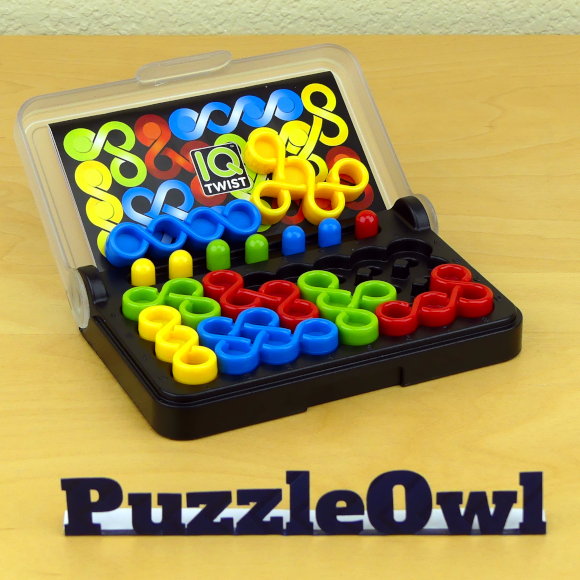
Wow! Factor: 
Quality & Design: 
Entertainment Value: 
Mental Workout: 
Sensory engagement: 
IQ Twist is in the crowded, popular category of packing puzzles, where it stands besides big names such as Kanoodle, Cat Stax, among others. It's PuzzleOwl's pick for the best puzzle from the lot of these, which lands it into 4th place overall.
Simply put, this puzzle executes well on the basic concept of the packing puzzle, with a creative twist that makes it a lot more fun. It doesn't get fancy with creative shapes (Cat Stax) or 3D challenges. In doing so, it's narrower in scope, but what it does it does really well.
The game comes with 120 challenges. For each challenge, some of the colored pegs are placed on the board. The puzzle is then to fit the remaining pieces on the board, making sure that the pegs match the color of the pieces placed on top of them.
What Stands Out
The Pegs Multiply the Fun: Compared to other puzzles in this category, IQ Twist is more interesting to solve because of how the pegs get used. The pegs introduce a different type of constraint, besides just the basic constraint of the enclosing shape. You know that a piece of that color has to be over that peg, but you don't know its orientation. This leads to more interesting logic that can be applied to try and deduce solutions, instead of just pure guess-and-check.
Good Difficulty Progression: The puzzle is interesting right away from the very first challenge. It has a nice ramp-up from there in terms of difficulty that keeps up the challenge.
Highly-Portable Case: The puzzle is self-contained as its own box, and the pieces and pegs are all fully contained within it. This makes it really easy to bring with you and solve on the go.
Drawbacks
- Even though the pegs make this a more interesting packing puzzle, most of the harder challenges still have a lot of guess-and-check work.
- The pegs don't fit perfectly into the board, sometimes being too loose or too tight.
- The game comes with some kind of sales pamphlet inside for other games from this company, which is unnecessary and can be mistaken for the instructions.
Bottom Line
IQ Twist is an improved version of the typical packing puzzle. Anyone who has previously played Kanoodle will likely welcome the additional "twist" that comes from using the pegs. It's a solid puzzle, but dues to it's nature it's not the most elegant, especially in the later challenges that mostly come down to much more experimentation rather than strategy.
Rubik's Cube
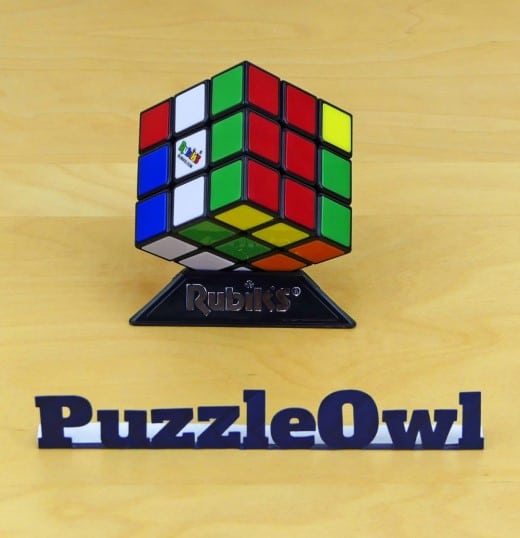 Age Range: 12+ (Best for 15+)
Age Range: 12+ (Best for 15+)
Wow! Factor: 
Quality & Design: 
Entertainment Value: 
Mental Workout: 
Sensory engagement: 
The Rubik's cube is a timeless classic, and holds a special place for me as my own first introduction to puzzles.
What Stands Out: This puzzle really shines for its quality and design. To have a 3-dimensional simple shape that can move like like that and produce literally trillions of trillions of different arrangements is simply ingenious.
There is also the pleasure of getting immersed in the puzzle itself, twisting it every possible way and straining your brain to figure it out.
Why It Falls Short: It's simply just too hard. For the typical person, the fun of the puzzle ends either with resignation or learning an algorithm to solve it. Some people then try to turn the challenge into solving the Cube as fast as possible, but this is no longer solving it as a puzzle.
Bottom Line: If you're not afraid of the challenge, or if you're a mathematician, this puzzle might be a top notch pursuit for you. Otherwise, you might want to look elsewhere.
Manifold
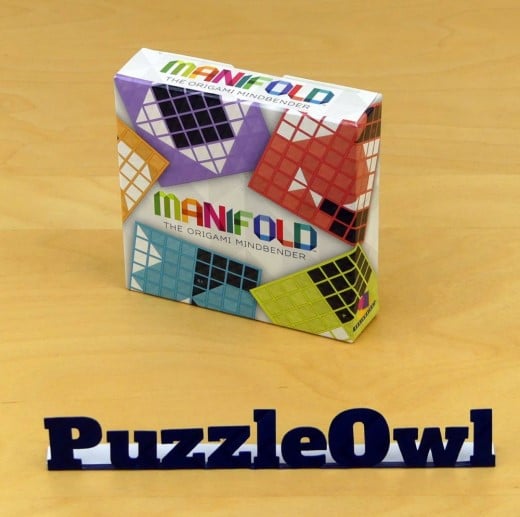 Age Range: 10+ (11+ Best)
Age Range: 10+ (11+ Best)
Wow! Factor: 
Quality & Design: 
Entertainment Value: 
Mental Workout: 
Sensory engagement: 
Manifold is a close cousin of Foldology that's at the #1 spot above. It also has 100 folding puzzles, however, there aren't any pictures. Instead, you're folding to get all the white colored pieces on one side, and all the black on the other side.
What Stands Out: Much like Foldology, this is a great concept and you're getting great value from the 100 puzzles. These puzzles are bit easier, and might be a bit more accessible for kids. It also looks great and comes packed in a colorful box.
Why It Falls Short: Simply put, it's just hard to choose this over Foldology, it doesn't have pictures!
Additionally, it's printed on thicker, glossy paper which can tear on the harder puzzles and can cause some frustrations. Although, this likely won't be an issue for more than a few puzzles.
Bottom Line: This is an awesome puzzle, despite some small drawbacks. Especially if you've just finished Foldology and craving more folding puzzles, this could be your fix.
Also Considered
Kanoodle
 The concept: use the differently-shaped pieces to fill up the rectangular grid. This game looks great, and for the right type of person it could be a lot of fun. But for me, there are some fundamental problems:
The concept: use the differently-shaped pieces to fill up the rectangular grid. This game looks great, and for the right type of person it could be a lot of fun. But for me, there are some fundamental problems:
- It comes with 200 challenges, but the first ~120 are entirely too easy; the setup took longer than the actual playing time for these.
- Solving the puzzles is fairly one-dimensional. It mostly comes down to just trying a bunch of different permutations.
- It ends up being heavily tilted to experimentation-type play instead of strategic thinking
- There is a nice twist in the end with 3D challenges, but these are underwhelming since at most you only need to place 3 missing pieces
Bottom Line: There are better options using this type of concept.
Cat Stax
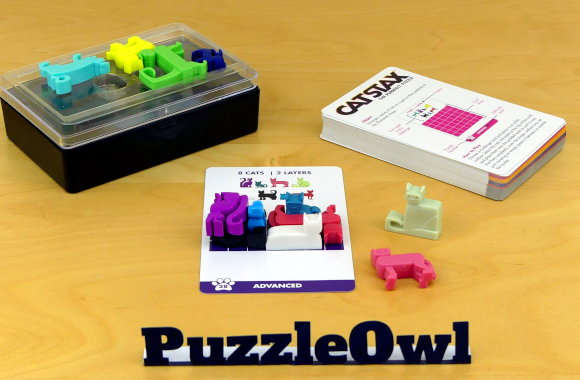 Speaking of which, this is one puzzle game similar to Kanoodle that I like better: you fill in shapes using the cat pieces.
Speaking of which, this is one puzzle game similar to Kanoodle that I like better: you fill in shapes using the cat pieces.
There are definite positives to this game. It's beautifully packaged, and the little cat pieces are quite cute. Also, it gets into 3D challenges right away, where you need to fill out a shape with several layers. But there are some drawbacks:
- The pretty cats don't like to stay still. Their shapes make them hard to keep on top of each other when stacking layers.
- With 3 or more layers, it gets very hard to place more cats without knocking the whole thing down.
Bottom Line: Pretty fun, Pretty frustrating.
Coogam Metal Wire Puzzle
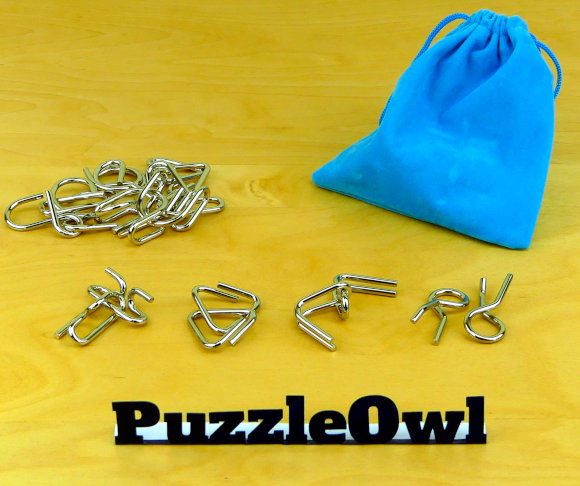 There are a ton of different versions of this same (or very similar) collection of metal wire puzzles. I picked the one by Coogam as it's the most popular one on Amazon.
There are a ton of different versions of this same (or very similar) collection of metal wire puzzles. I picked the one by Coogam as it's the most popular one on Amazon.
It's a disentanglement puzzle concept: separate the two twisted metal pieces from each other. There are 16 puzzles in the set, and they're a reasonable price. I could see this having a lot of value, for example as a nice little brain teaser to give out to a group of kids.
However, most (15 out of 16) of the puzzles rely on a very similar technique to separate the pieces. So, there's not much real diversity although they all look very different at first.
Bottom Line: Good value for kids. Otherwise, the Hanayama puzzles are miles ahead with this same concept.
On The Dot
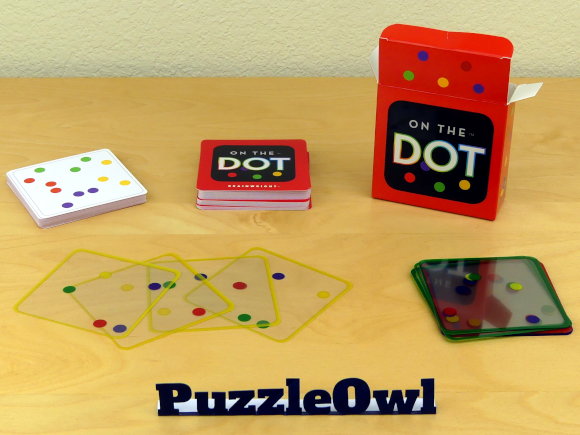 This was a new puzzle for me in 2019. Concept: you take the 4 transparent cards and position them on top of each other to match the challenge card.
This was a new puzzle for me in 2019. Concept: you take the 4 transparent cards and position them on top of each other to match the challenge card.
Nice packaging, but this game is really lacking as a puzzle. There are no difficulty levels! And the base challenge is low: just guess and check.
Actually in the instructions, they try to make it a timed game e.g. "see how fast you can do it and race with a friend". So what is it, a puzzle or a multiplayer competitive game? Seems like it's trying to do both. However, at least a puzzle, it falls short.
Bottom Line: Not much of a puzzle, might be a good educational toy for young kids.
Fold - Fat Brain Toys
This is the third paper-folding puzzle set that I considered for this guide. It also ranks as third for me among these puzzles.
It's designed by Ivan Moscovich, a pretty famous puzzle designer. There are actually 10 different types of folding puzzles in the set. And each type comes with a few challenges, so there's quite a bit going on here.
Of the 10 puzzle types, it was pretty hit or miss for me. I really enjoyed challenge #4 "Three By Four Rectangle" and #6 "Four Square", but wasn't too keen on the others. On top of that, these folding puzzles are printed on very heavy paper that makes it hard to fold flat for some of the challenges.
Bottom Line: Cool variety with 10 different challenge types, but not my top pick for origami puzzles.

